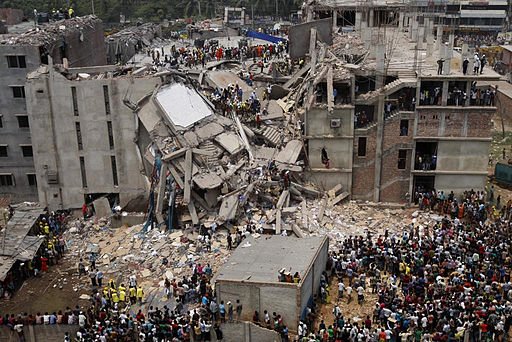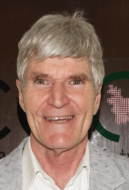
The Rana Plaza building collapse in 2013 was considered the deadliest accidental structural failure in modern human history
Brad Loewen is the chief safety inspector for the Bangladesh Accord on Fire and Building Safety. An independent agreement designed to make all garment factories in Bangladesh safe, the Accord came into being following the collapse of the Rana Plaza building in 2013 in which more than 1,100 people were killed and over 2,500 injured.
Brad has – arguably – the biggest job in health and safety in the last decade. His work in Bangladesh is impacting a nation of approximately 4 million workers and is dramatically improving conditions for some of the most exploited people in the world.
It is a sign of how important Brad’s job is at the Accord, that elsewhere it has been referred to as the “key fire-protection engineering role in the world”.
The Accord is a unique collaboration of over 200 apparel brands from 20 countries in Europe, North America, Asia and Australia, as well as two global trade unions, eight Bangladeshi trade unions and four NGO witnesses.
The Accord is an independent, legally-binding agreement to work towards a safe and healthy Bangladeshi ready-made garment industry. The purpose of the Accord is to enable a working environment where no worker needs to fear fires, building collapses or other accidents that can be prevented with reasonable health and safety measures.
Andy Cartland, founder and MD at Acre, the market leader in sustainability and safety recruitment, speaks to Brad about what may very well be the most challenging role in health and safety.
Andy: You’ve spent a large part of your career as a regulator in your native Canada, what attracted you to the Accord role?
Brad: Growing up I had been a little envious of those friends who had spent time working in international development overseas. At the time I was very involved in my local community. I was a volunteer fire fighter from the age of 16 and between that and then college, the opportunity just hadn’t presented itself. So when I saw the ad for this role, I just knew it was something I wanted to do.
Andy: You were fighting fires at 16?
Brad: Yes. I think the minimum age is now 18, but it’s from those early experiences that I became interested in fire protection. I went on to become the trainer in our department and when it came time to decide what to do at college, I opted for a degree in fire protection engineering at the University of Maryland.
Andy: The tragedy at Rana Plaza made headlines around the world; did the high profile of the incident have a bearing on your decision to apply for the role?
Brad: I doubt those terrible images will ever leave me and I’m sure the same is true of anyone who saw the footage of the disaster. There were two key questions being asked at the time: firstly, how could this have happened? And secondly, ‘how do we prevent this ever happening again?’
So when I first saw the role advertised, I was excited at the prospect of being able to use my skills and my experience as a regulator and enforcer of building and fire codes in a country where they were very much needed.
My first question however, was ‘Is it real?’ I didn’t want anything to do with a public relations exercise, so I didn’t apply for the role until I’d done enough research to satisfy myself that this was a genuine attempt to make things safer for garment workers in Bangladesh.
Andy: As chief safety officer, you have around 1,600 factory buildings to inspect. Where do you start with a project so vast?
Brad: As the Accord’s first employee, I just had to start at the beginning. Although we had the agreement, there was no standard for buildings to be assessed against. I met with lots of people and groups who had shared concerns about the situation and we drafted a standard. Then I did the easy part – I adopted the standard. When you’re a one-person standards organisation this is by far the most straightforward piece of the puzzle. Once the standard was adopted, I was able to start evaluating the buildings.
Andy: How long did that evaluation process take?
Brad: Every factory under the Accord had been evaluated by September 2014 – a year and four months after the Rana Plaza collapse. Time was of the essence and there was no way that I could personally inspect all 1,600 buildings, so I hired consultant engineers to assist. That gave me time to focus on the next challenge, which was to develop the necessary protocols and reporting structures to ensure remediation.
Andy: How important has it been to recruit locally?
Brad: The plan has always been to ensure that the Accord leaves a legacy. If we had come here in 2013 and helicoptered in a group of international contractors it might have worked in the short term, it probably would have made for a nice story, but it wouldn’t have kept the millions of people who work in the garment trade safe over the long term.
We want to leave a legacy in the form of skills, so we prioritise local recruitment and now have a team of over 100 engineers and trainers. Fire protection engineering was unknown in Bangladesh until the Accord, but now all of the remediation work we do with factory owners is done by Bangladeshi engineers.
Andy: Do you have a vision for the end of the project?
Brad: The vision is that all 1,600 factory buildings under the Accord will be safe places to work, the systems we’ve introduced will ensure that safety standards will be maintained and each factory will have an occupational safety and health committee.
Andy: You’ve achieved a huge amount in the 20 or so months you’ve been in post, what’s the next challenge?
Brad: The next challenge is setting up the occupational safety and health committees at each factory producing for Accord brands. These committees, which will be made up of elected employees and managers, will be able to monitor and address safety and health issues on a day-to-day basis. They’re absolutely key to ensuring that the aims of the Accord continue to be realised after the five-year agreement. However, to achieve this, we first have to overcome the resistance to worker organisation that’s prevalent in Bangladesh. And that is most certainly a challenge.
Andy: What advice would you give to fellow health and safety professionals?
Brad: Be an expert but don’t act like an expert. Don’t bring your knowledge to the situation before you’ve had time to determine what’s going on and the only way to do that is to listen first. Throughout my career, I’ve found that offering people a sympathetic ear is usually the quickest way to get positive results.
 Brad Loewen is the Chief Safety Inspector of the Accord on Fire and Building Safety in Bangladesh. Brad has a degree in Fire Protection Engineering from the University of Maryland. He has over 30 years experience as a fire protection engineer. He served as a code official for the City of Winnipeg, Manitoba Fire Commissioners Office, and the Canadian Federal Fire Commissioners Office. Brad taught a masters level course in Fire Protection Engineering at the University of Manitoba.
Brad Loewen is the Chief Safety Inspector of the Accord on Fire and Building Safety in Bangladesh. Brad has a degree in Fire Protection Engineering from the University of Maryland. He has over 30 years experience as a fire protection engineer. He served as a code official for the City of Winnipeg, Manitoba Fire Commissioners Office, and the Canadian Federal Fire Commissioners Office. Brad taught a masters level course in Fire Protection Engineering at the University of Manitoba.
 Andy Cartland is founder and MD at Acre, the market leader in sustainability and safety recruitment for over a decade. Andy is also a Trustee for Global Action Plan a charity that brings people together and inspires them to take practical environmental action, and an advisor to social impact consultancy, Uscreates.
Andy Cartland is founder and MD at Acre, the market leader in sustainability and safety recruitment for over a decade. Andy is also a Trustee for Global Action Plan a charity that brings people together and inspires them to take practical environmental action, and an advisor to social impact consultancy, Uscreates.
Fire Safety in 2023 eBook
SHP's sister site, IFSEC Insider has released its annual Fire Safety Report for 2023, keeping you up to date with the biggest news and prosecution stories from around the industry.
Chapters include important updates such as the Fire Safety (England) Regulations 2022 and an overview of the new British Standard for the digital management of fire safety information.
Plus, explore the growing risks of lithium-ion battery fires and hear from experts in disability evacuation and social housing.




